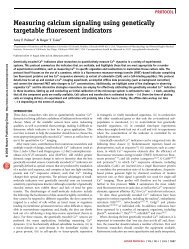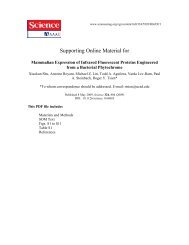THE GREEN FLUORESCENT PROTEIN - Tsien
THE GREEN FLUORESCENT PROTEIN - Tsien
THE GREEN FLUORESCENT PROTEIN - Tsien
Create successful ePaper yourself
Turn your PDF publications into a flip-book with our unique Google optimized e-Paper software.
524 TSIENhave the largest gap in wavelengths between excitation and emission peaks ofany of the GFPs. This large Stokes’ shift could be advantageous in supportinglaser action, where it is important that the dye should have as little absorbanceas possible at the wavelengths of fluorescence and lasing.PHENOLATE ANION WITH STACKED π-ELECTRON SYSTEM (CLASS 4) Thelongest wavelengths currently available by mutation result from stacking anaromatic ring next to the phenolate anion of the chromophore. So far the aromaticring has always come from the side chain of residue 203, and residue65 is Gly or Thr instead of Ser, to promote ionization of the chromophore.All four aromatic residues at that position 203 (His, Trp, Phe, and Tyr) increasethe excitation and emission wavelengths by up to 20 nm, with the shiftsincreasing in the stated order (30). These mutants were rationally designedfrom the crystal structure of S65T GFP in the expectation that the additionalpolarizability around the chromophore and π-π interaction would reduce theexcited state energy, that is, increase both the excitation and emission wavelengths.The mutants would have been nearly impossible to find by randommutagenesis, because all three bases in the original codon (ACA) encodingThr203 would have to be replaced to encode an aromatic amino acid, and anyrandom mutation rate high enough to give a significant probability of changingthree bases in one codon would mutate so many other residues as to kill theprotein.The actual crystal structure of a mutant containing Tyr203 has verified thatits aromatic ring stacks next to the chromophore (RM Wachter, GT Hanson,AB Cubitt, K Kallio, RY <strong>Tsien</strong>, SJ Remington, manuscript in preparation).Mutation of Gln69 to Lys (Q69K) gives an additional shift of about 1–2 nm,resulting in an emission peak around 529 nm, the longest now known (Table 1).Although 529 nm itself is rather greenish, the tail at longer wavelengths issufficient to give the fluorescence an overall yellowish appearance, which isclearly distinguishable by eye from the more greenish emission of GFP classes1–3. Therefore class 4 GFPs have been called YFPs for yellowish fluorescentproteins (50), though this name has also been used for a fluorescent protein fromVibrio fischeri (16). The so-called BioYellow variety marketed by Pharmingen(51) is identical to RSGFP4 (46), a class 2 GFP with emission maximum at505 nm, the same as the wild type.INDOLE IN CHROMOPHORE DERIVED FROM Y66W (CLASS 5) Substitution ofTrp for Tyr66 produces a new chromophore with an indole instead of a phenolor phenolate (21). Excitation and emission wavelengths are 436 and 476 nm,intermediate between neutral phenol and anionic phenolate chromophores. Theincreased bulk of the indole requires many additional mutations to restore






